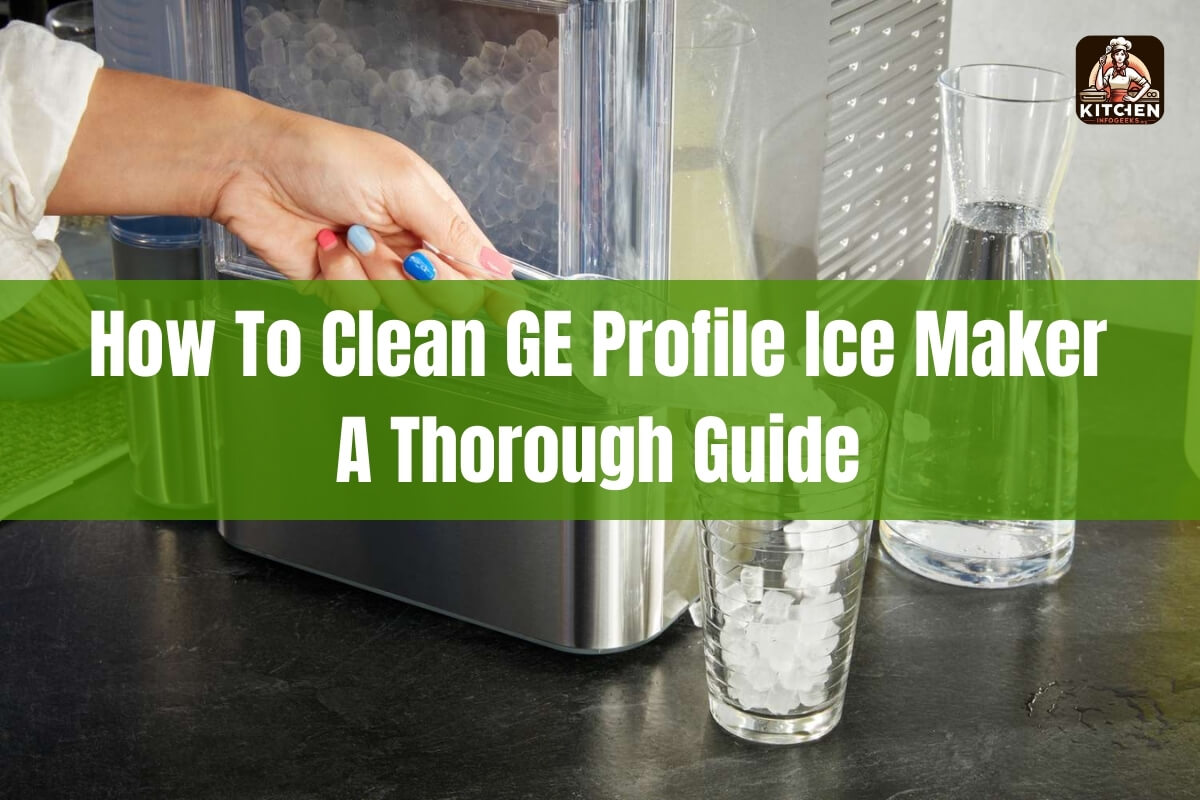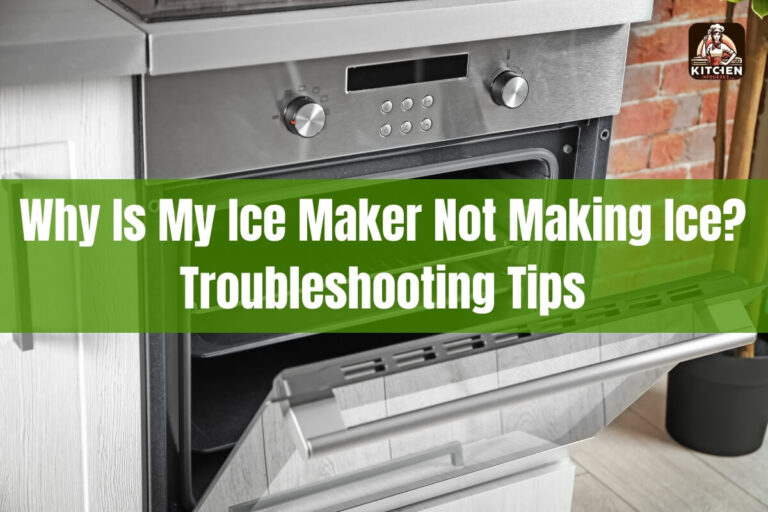
Are you struggling to keep your GE Profile ice maker clean and functioning optimally? Maintaining a clean ice maker is crucial for ensuring fresh, great-tasting ice cubes and prolonging the lifespan of your appliance. In this comprehensive guide, we’ll dive deep into the step-by-step process of cleaning and descaling your GE Profile ice maker, covering everything from weekly maintenance to deep cleaning routines.
Understanding Your GE Profile Ice Maker Model
Before we begin, it’s essential to identify your specific GE Profile ice maker model. GE offers different models, some with a large round button on the front, while others lack this feature. The cleaning instructions may vary slightly between models, so it’s crucial to follow the appropriate guidelines for your particular unit.
To determine your model, simply locate the round button on the front panel. If your ice maker has this button, follow the cleaning instructions for “models with a round button.” If your unit lacks this button, refer to the instructions for “models without a round button.”
Preparing for the Cleaning Process
Gather the necessary supplies before starting the cleaning process. You’ll need:
- White vinegar or a designated ice maker cleaning solution (bleach-based)
- Clean towels or cloths
- Soft sponges or brushes (for exterior cleaning)
- Stainless steel cleaner (if your unit has stainless steel components)
Once you have the supplies ready, follow these preparatory steps:
- Unplug the ice maker and allow it to sit for at least an hour. This step is crucial for ensuring a thorough cleaning process.
- Remove the water filter (if present) and replace it with the reservoir’s screened intake cap. This step ensures proper water circulation during the cleaning cycle.
By taking these initial steps, you’ll be ready to dive into the cleaning routine tailored to your GE Profile ice maker model.
The Weekly Cleaning Routine
GE recommends cleaning your ice maker once a week to maintain optimal performance and prevent the buildup of biofilms or mold. Regular weekly cleaning is essential for ensuring fresh, great-tasting ice cubes.
Here’s the step-by-step process for the weekly cleaning routine:
- Create a cleaning solution by mixing five cups of hot water (100-120°F) with one teaspoon of household bleach. Avoid using soap, as it can leave residue in the water reservoir.
- Pour the cleaning solution into the water reservoir up to the fill line.
- Initiate the cleaning cycle by pressing the designated “clean” button or sliding the rear switch to the “clean” position, depending on your model.
- The cleaning indicator light will illuminate, and the cleaning cycle will begin. During this cycle, the cleaning solution will circulate through the ice maker’s internal components.
- After approximately three minutes, the cleaning cycle will pause, and the indicator light will start pulsing or change color. This is your cue to drain the ice maker.
- Unhook the drain hoses at the back of the unit and lay them down to drain the cleaning solution into a sink or bucket. Remember to remove the drain plugs to allow for complete drainage.
- Once the water stops flowing, replace the drain plugs and reconnect the drain hoses.
- Rinse the water reservoir by adding five cups of fresh water and initiating another cleaning cycle. Repeat this rinsing process at least two more times, using fresh water each time.
- After the final rinse, return the rear switch to the “ice” mode (if applicable) and refill the water reservoir with fresh water.
By following this weekly cleaning routine, you’ll help maintain the freshness of your ice cubes and prevent the buildup of contaminants or mineral deposits within the ice maker.
Deep Cleaning and Descaling
In addition to the weekly cleaning routine, it’s essential to perform a deep cleaning and descaling process periodically. The frequency of this process depends on the hardness of your water supply and your usage patterns.
Here’s a general guideline for descaling frequency based on water hardness levels:
- 0-4 grains per gallon (gpg): Descale every 2-4 months
- 4-7 gpg: Descale every 1-2 months
- 7-10 gpg: Descale every 3-4 weeks
- Greater than 10 gpg: Descale every 2-3 weeks
To descale your GE Profile ice maker, follow these steps:
- Fill the water reservoir with hot vinegar (100-120°F) up to the maximum fill line.
- Run up to three cleaning cycles using the vinegar solution, following the same steps as the weekly cleaning routine.
- Leave the vinegar solution in the unit for 18 hours and place a vinegar-soaked towel on the ice chute overnight. This prolonged exposure helps dissolve stubborn mineral buildup.
- Clean the ice maker’s sensors with vinegar and wipe them clean with water.
- Drain the vinegar solution and run three rinse cycles using fresh water for each rinse.
Alternatively, you can purchase a dedicated ice maker cleaning kit and follow the instructions provided by the manufacturer.
Regular descaling is crucial for preventing mineral deposits from accumulating and impeding the ice maker’s performance. By following the recommended descaling frequency based on your water hardness, you’ll ensure your GE Profile ice maker continues to operate efficiently and produce fresh, great-tasting ice cubes.
Cleaning the Exterior and Components
In addition to the interior components, it’s essential to keep the exterior of your GE Profile ice maker clean and well-maintained. Here’s how to tackle the various exterior components:
Ice Bin
- Remove the ice bin from the ice maker.
- Clean it with a soft cloth dampened with soapy water. Avoid using harsh solvents or chemicals.
- Rinse the bin thoroughly and dry it with a soft cloth.
Drip Tray
- Remove the drip tray from the ice maker.
- Use a soft cloth dampened with hot (100-120°F) soapy water to clean the tray. Again, avoid solvents or harsh chemicals.
- Dry the tray thoroughly with a soft cloth.
- Wipe the drip tray dry after each use to prevent mineral deposits from forming.
Exterior Surfaces
- For non-stainless steel surfaces, use a soft cloth dampened with soapy water to gently wipe down the exterior.
- For stainless steel surfaces, use a dedicated stainless steel cleaner and a soft sponge. Clean in the direction of the brush lines to maintain the finish.
By regularly cleaning the exterior components, you’ll not only maintain a sleek, hygienic appearance but also prevent the buildup of spills, dirt, or mineral deposits that could potentially affect the ice maker’s performance.
Maintaining a Clean Ice Maker Long-Term
Keeping your GE Profile ice maker clean is an ongoing process, and several factors can impact the required cleaning frequency. Here are some tips for maintaining a clean and well-functioning ice maker over the long term:
- Water Hardness: As mentioned earlier, the hardness of your water supply plays a significant role in determining the frequency of descaling. If you live in an area with hard water, you may need to descale more frequently.
- Usage Patterns: Heavy usage of your ice maker can lead to increased buildup of minerals or contaminants, requiring more frequent cleaning.
- Reducing Mineral Buildup: To minimize mineral buildup, consider using a water filter or softener system in your home. This will help reduce the amount of minerals entering the ice maker, extending the time between descaling cycles.
- Troubleshooting: If you notice any issues with your ice maker, such as blinking lights or sensor problems, refer to the troubleshooting section of your owner’s manual or contact GE customer service for assistance.
By staying vigilant and following the recommended cleaning schedules, you’ll ensure that your GE Profile ice maker continues to produce fresh, great-tasting ice cubes for years to come.
Benefits of a Well-Maintained Ice Maker
Investing time and effort into properly cleaning and maintaining your GE Profile ice maker offers numerous benefits:
- Improved Ice Quality and Taste: Regular cleaning and descaling remove contaminants, mineral buildup, and biofilms, ensuring that your ice cubes taste fresh and crisp.
- Prolonged Appliance Lifespan: Proper maintenance helps prevent issues like mineral buildup, which can lead to costly repairs or premature failure of your ice maker.
- Energy Efficiency: A clean and well-maintained ice maker operates more efficiently, potentially saving you money on your energy bills.
- Peace of Mind: Knowing that your ice maker is clean and well-maintained provides peace of mind, ensuring that the ice cubes you consume are safe, fresh, and free from potential contaminants.
The Bottom Lines
Maintaining a clean and well-functioning GE Profile ice maker is essential for enjoying fresh, great-tasting ice cubes and prolonging the life of your appliance. By following the step-by-step cleaning and descaling routines outlined in this guide, you can keep your ice maker operating at its best, preventing issues like mineral buildup, biofilm growth, and contamination.
Remember, consistency is key. Stick to the recommended weekly cleaning schedule and descale according to your water hardness levels. Additionally, don’t neglect the exterior components, as keeping them clean and well-maintained contributes to the overall performance and appearance of your ice maker.
With a little effort and attention, your GE Profile ice maker will continue to provide you with a steady supply of fresh, crisp ice cubes for years to come.






